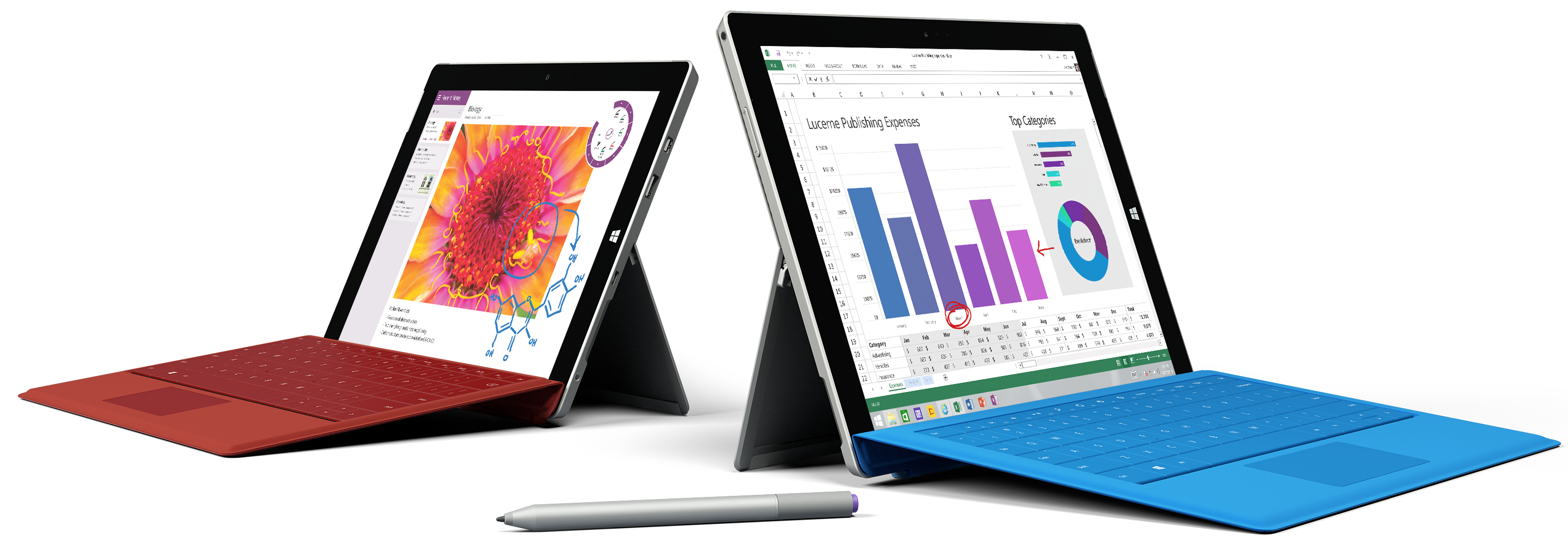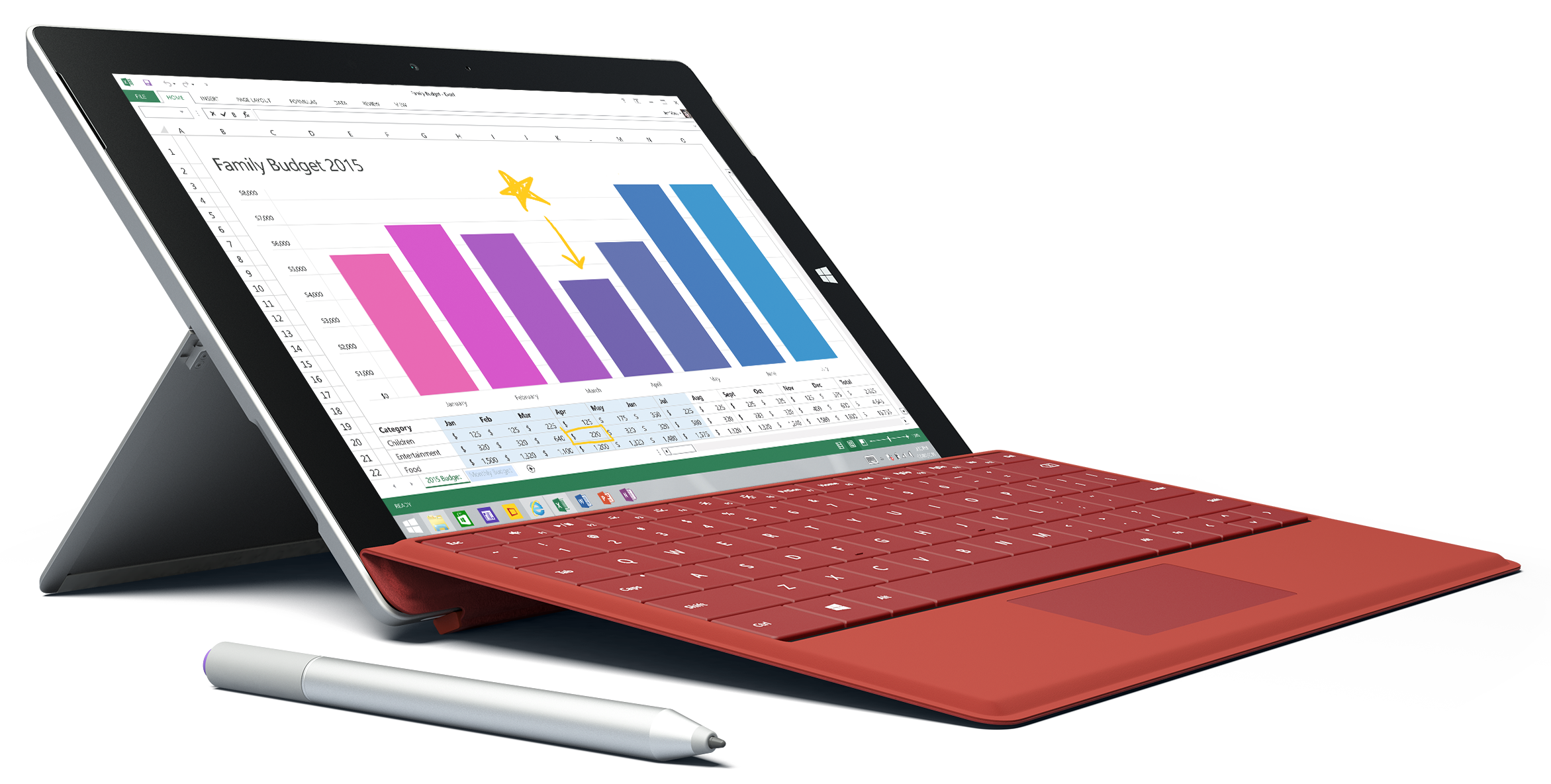New Surface 3 Tablet Abandons Windows RT, Rocks Intel Cherry Trail Chip (Updated)
Microsoft's corporate vice president of the Surface division, Panos Panay, today announced the Surface 3 tablet. The big news here is that the device doesn't sport Windows RT like the previous two versions, but the full-blown release of Windows 8.1 powered by an Intel Atom chip. Customers can pre-purchase the tablet today for a starting price of $499. The tablet ships May 5.
The Surface 3 features a 10.8-inch ClearType display with a 1920 x 1280 resolution, a 3:2 aspect ratio, support for 10-point touch input and support for the Surface Pen. Backing this screen is an Intel quad-core Atom x7-Z8700 (Cherry Trail) processor (1.6 GHz, 2.4 GHz burst) and a battery promising up to 10 hours on a single charge.
The specifications also show that the new Surface 3 ships in two flavors: 64 GB of internal storage with 2 GB of RAM, and 128 GB of storage with 4 GB of RAM. There's also a handful of sensors, a 3.5MP camera on the front, an 8MP camera with autofocus on the back, two speakers with Dolby audio, and Wireless AC and Bluetooth 4.0 connectivity. Ports include a full-size USB 3.0 port, a microSD card reader, a mini DisplayPort and more.
The new Surface 3 tablet comes equipped with a 1-year subscription to Office 365 Personal. The tablet also includes the Surface Pen (blue, red, black or silver), which is only compatible with the Surface 3 and the Surface 3 Pro. A FAQ also revealed that the new tablet will come packed with a thinner, lighter 13 W power supply that can only be used on the Surface 3 tablet. The device weighs a mere 1.37 pounds and measures just 0.34 inches thin.
So what's the difference between the new Surface 3 tablet and the Surface Pro 3? Launched back in May 2014, the Surface Pro 3 is faster, sporting an Intel Core i3, Intel Core i5 or Intel Core i7 processor, depending on the model. The Pro edition also includes a 12-inch ClearType screen with a 2160 x 1440 resolution, 3:2 aspect ratio and multi-touch support. Storage options range from 64 GB to 512 GB, and RAM options span from 4 GB to 8 GB.
The good news here for many customers is that they can run their desktop applications on the Surface 3. The previous model, the Surface 2, featured an Nvidia Tegra 4 chip and Windows RT, which isn't compatible with x86-based software. Windows RT turned off many consumers, so it's not surprising that Microsoft chose to take the Atom route with its new Surface 3.
Customers wanting to use Surface 3 on-the-go can purchase the tablet with 4G LTE capabilities. Options include the Surface 3 with 64 GB of internal storage and 2 GB of RAM, and 128 GB of storage with 4 GB of RAM. Unfortunately, Microsoft didn't provide pricing but did report that these two versions will ship on June 26.
Get Tom's Hardware's best news and in-depth reviews, straight to your inbox.
Update, 3/31/15, 11am PST: We asked Microsoft about the obvious question with the Surface 3: Why did the company go with Intel's Cherry Trail platform as opposed to the Windows RT/ARM configuration? We didn't get much in reply, but we were told that ARM devices are still on Microsoft's road map (although we assumed that to be the case if for no other reason than so many smartphones have ARM chips) and that Windows RT will be getting an update soon that will give it "some of the functionality of Windows 10."
Follow Kevin Parrish @exfileme. Follow us @tomshardware, on Facebook and on Google+.

Kevin Parrish has over a decade of experience as a writer, editor, and product tester. His work focused on computer hardware, networking equipment, smartphones, tablets, gaming consoles, and other internet-connected devices. His work has appeared in Tom's Hardware, Tom's Guide, Maximum PC, Digital Trends, Android Authority, How-To Geek, Lifewire, and others.
-
J0E1 Why does every article so far on Surface 3 fail to mention the keyboard is $150 extra? Yet, every picture includes it ...Reply -
canadianvice The KB AND the pen are separate purchases this time round. MS doesn't seem to get that they really should bundle the KB at a minimum.Reply -
d_kuhn I agree... I have a Surface Pro and the keyboard is absolutely required in order to make the system fully functional. Windows 8 is not capable as a 100% tablet OS... you may be able to do everything - but you're not going to want to. Add the KB/Touchpad and it goes from a frustrating mess to a competent ultra-portable machine.Reply -
Buggsbuny I bought a Chromebook for my niece to use for college work. I've been in the enterprise IT business for 20+ years and this was my first encounter with a Chromebook. Setting it up for her, all my skepticism or apprehension was blown away after about 30 minutes using it. This paperlight $199 laptop can do anything a normal user would need it to dot. I simply can't imagine why I would want or need a $630 (499 + 130 keyboard) Windows machine? Now that Office or Google Docs are online and basically free, the days of needing a $500+ laptop seem crazy.Reply
Windows laptop have a niche and its more of an enterprise thing at this point. I have to imagine the future of the consumer market for Windows is basically going into the grave unless you are a die hard PC gamer. -
rluker5 I wish I didn't already have all the tablets/laptop I wanted. I'd charge this one by the tv and plug it in as an htpc with Bluetooth k+m. It looks like it can beat last year's i3 all in ones.Reply
As for bugsbunnie's chromebooks, Hp's stream7 with bt k+M will set you back like $120 and is comparably capable with bonuses of windows + portability + 40% off. Yes, the low end stuff is getting cheaper. -
GreaseMonkey_62 Finally got MS to abandon Windows RT. Intel has been making Atom processors better but I'm still not a big fan of them. That being said this looks like a nice alternative to the Surface Pro.Reply -
CelicaGT Dammit, I literally just picked up the SP3, i5 version. I would have loved this smaller lighter one instead to replace my aging W500 (upgraded to win8 from7). Love the tablet form factor for the 2nd computer. I have to agree on the type cover, definitely not worth $130 but oh so necessary.Reply -
adnf ReplyWhy does every article so far on Surface 3 fail to mention the keyboard is $150 extra? Yet, every picture includes it ...
I frankly think this omission on Microsoft's part is a little shady and it decreases my trust in the company. -
stevejnb Right direction, wrong price. Adopting the Apple pricing model is just going to drive users like me - who like Surface products - away.Reply
Not paying $600+ - starting price - for an Atom tablet - prior to having a keyboard stuck on there.
Add a keyboard to that starting price and it's bordering on OK.... Bordering. But seriously, the Surface line is going full Apple.
Anyone know what Acer is producing two gens down from the Iconia W700? I'm likely buying whatever that is over a Microsoft product.

